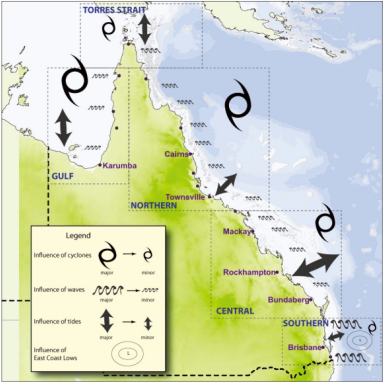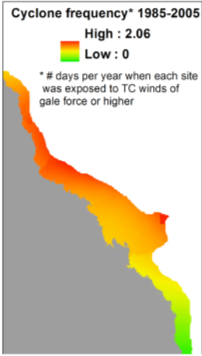|
|
Energy magnitudeEnergy magnitude describes the power of water that shapes the coastline, sea floor and patterns of biota and can be correlated with sediment grain size, e.g. wave energy from cyclones is capable of tossing boulders across the reef crest; cobble and pebble beaches are usually found in areas of relatively higher wave energy. Water column energy plays an important role in the movement of substrates and geomorphological processes (e.g. erosion and accretion), influencing beach formation[7], estuary configuration (formed through interactions of wave, tide and river energy power)[3][4], shaping geomorphological features of rocky cliffs, platforms and shores[9], coral reefs and lagoons[8][1][2]. Quick facts
Energy magnitude is usually modelled in continuous hydrodynamic models, informed by digital bathymetry and other physical factors incorporated into mathematical models (e.g. AusWave, eReefs, BRAN etc.). These models include directionality or vectors, which are not considered in the static attribute of energy magnitude. For classification purposes it is more useful to summarize energy magnitude across time series (e.g. mean, standard deviation, maximum, minimum etc.) such as seasons, years etc. (e.g. eReefs Model) to create static spatial outputs suitable for classification at the required spatial scale (level). Outputs can be split into categories appropriate to that scale (e.g. for seascape and habitat scales the categories of very low, low, medium, high, very high). Queensland Intertidal and Subtidal Classification SchemeEnergy magnitude is defined, for the purposes of the Intertidal and Subtidal Classification Scheme, as the relative strength of water column energy force, independent of the source of the energy which is a separate attribute of the water column. Attribute category table - Energy magnitude
Additional Information
References
Last updated: 15 July 2019 This page should be cited as: Department of Environment, Science and Innovation, Queensland (2019) Energy magnitude, WetlandInfo website, accessed 8 May 2025. Available at: https://wetlandinfo.des.qld.gov.au/wetlands/ecology/aquatic-ecosystems-natural/estuarine-marine/itst/energy-magnitude/ |

 — Department of the Environment, Tourism, Science and Innovation
— Department of the Environment, Tourism, Science and Innovation



